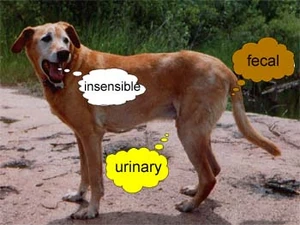thumb|300px|left|How to treat diarrhea in dogs.

Fluid is lost from the body by breathing/panting (insensible), normal urination or polyuria, (urinary), and normal bowel movements or diarrhea (fecal). They're called sensible losses because they can be easily detected and measured. Vomiting fits into the sensible category and when it's severe, dehydration can take place, as well as with diarrhea and polyuria.
Diarrhea can be a symptom of many different conditions, and if it persists, should be diagnosed by a vet. Home remedies are not recommended until a vet has definitively diagnosed the problem.
Some possibilities include food sensitivity and Inflammatory Bowel Disease.
When diarrhea is a problem, the possibilities for both dehydration [1] and hypoglycemia increase [2][3][4]. The insulin dose you give depends partly on the meal being digested at a normal rate. When the food passing through the system speeds up in this manner, the insulin is still being absorbed at its usual rate [5]. It could mean that there's not enough food to match the insulin dose and a hypo could occur. You and your vet may want to temporarily decrease the insulin dose until you are both satisfied the diarrhea is under control. ![]()
References
- ↑ Fluid Loss From Diarrhea. Washington State University.
- ↑ Hanas, Ragnar (2006). Vomiting/Diarrhea. Children With Diabetes.
- ↑ Hanas, Ragnar (2006). Insulin Requirements Decrease With Diarrhea/Vomiting. Children With Diabetes.
- ↑ Hypoglycemia. Intervet UK.
- ↑ Other Medical Problems. Drugs.com.
More Information
- Acute Diarrhea in Dogs Petplace.com
- Chronic Diarrhea in Dogs Petplace.com
- Gastrointestinal Signs in Endocrine Diseases-Dogs & Cats Provet UK
- Chronic Diarrhea WSAVA 2001
- Diagnosis and Management of Refractory Diarrhea WSAVA 2004
- Diagnosis and Management of Refractory Diarrhea WSAVA 2003
- Drugs Used in Treatment of Diarrhea Merck Veterinary Manual
- Antidiarrheal Drugs Merck Veterinary Manual
- Fiber in Pet Foods Pet Education.com-Drs. Foster & Smith
- Sodium & Chloride Deficiency in Diarrhea Pet Education.com-Drs. Foster & Smith
- Potassium Deficiency & Diarrhea Pet Education.com-Drs. Foster & Smith
- Diarrhea-Dietary Management in Dogs PetsHealth
- Digestive Disturbances in Dogs PetsHealth
- Chronic Diarrhea District of Columbia Academy of Veterinary Medicine-October 2000
- Fluid therapy in vomiting and diarrhea Veterinary Clinics of North America-Small Animal Practice 2008
- Dog Diarrhea: When is it Serious? New Hope Animal Hospital
- Tylosin-Responsive Chronic Canine DiarrheaVeterinary Clinics of North America
- Diarrhea Washington State University
- Nutritional Management of the Most Common Digestive Diseases in Dogs and Cats WSAVA 2009
- Probiotics, Prebiotics, and Synbiotics. What Are They and When Should They Be Implemented? WSAVA 2009
- Adverse Reactions to Food: Chronic Adverse Immunological Responses to Dietary Antigens Cave-WSAVA 2010
- Dietary Approach to Gastrointestinal Disorders--Acute Gastroenteritis-Cave WSAVA 2010
- How I Treat--Small Intestinal Dysbacteriosis Steiner-WSAVA 2010
- Diarrhea Caused by Giardia and Clostridium Perfringens Enterotoxicosis Todd R. Tams Atlantic Coast Veterinary Conference 2001
- Diagnosis and Management of Large Intestinal Disorders in Dogs Todd R. Tams Atlantic Coast Veterinary Conference 2001